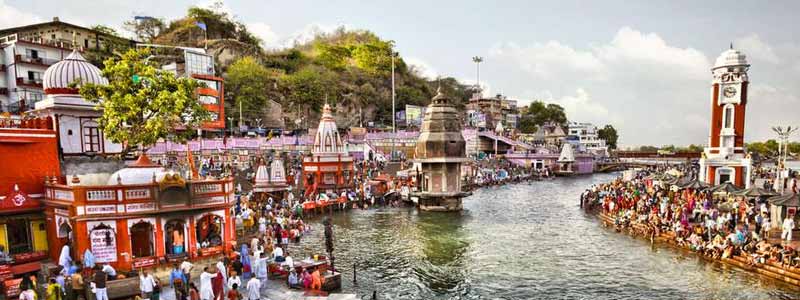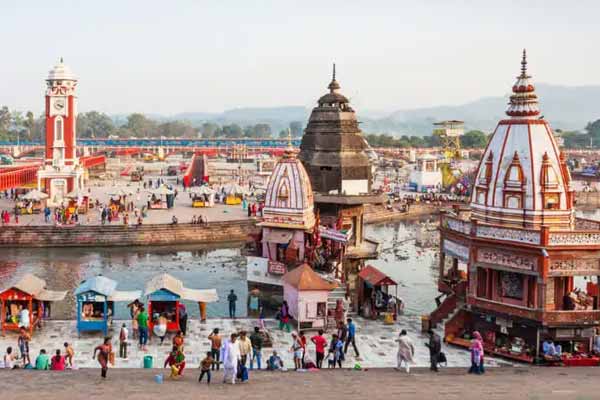Top 8 Places To Visit In Haridwar is located on the bases of the Shivalik range of Himalayas. It is a place of enormous natural exquisiteness and home to the Holy River Ganges. Also recognized to Hindus as Mayapuri, Gangadwara and Mokshadwar, it is one among the most blessed cities in India. It is correspondingly a significant pilgrimage town for the Hindus. Sumptuous green forests and sparkling pure water of river Ganges with background of mountains creating the enchanting beauty of this holy city invites 1000s of tourists every year. Ghats looks striking as hundreds of deepaks (lamps) and marigold flowers glide and light up the river Ganges in evening hours.
The entire Haridwar is alienated in various small areas such as Bhupatwala, Brahampuri, Devpura,HaipurKalan, Har Ki Pauri, Jwalapur, Mayapur, Motichur, Ranipur, and Shivalik Nagar. Being a popular tourist destination it has some amazing food joints to eat at. Kashyap Kachori Bhandar, Mohan Ji Puri Wale, Bhagwati Chhole Bhandar, Mathura Walo Ki Pracheen Dukan, Pandit Sevaram Sharma Doodh Wale are few places that you must visit.
The Ardh Kumbh Mela, Dipawali, Holi, Kanwar Mela, Ganga Dussehra, Kartik Poornima, Kavad Mela, Somvati Amavasya Mela are among few festivals and fairs that are celebrated with utmost zeal and passion in Haridwar. An essential part of Haridwar‘s ethos is its Yoga Ashrams. The place is an abundant source of Ayurvedic medications and herbal therapies. Take part in Ganga Aarti, Yoga Sessions, and Meditation Sessions compulsorily when you are here. Pay visits to the Ashrams and attend lectures by Gurus to learn newer aspects of life Top 8 Places To Visit In Haridwar.

Har ki Pauri
The Har Ki Pauri temple carries even more significance, because it preserves the footprints of Lord Shiva even to this day. The scene at the Ganges ghats can itself stir your soul and immerse you in the ocean of devotion. The entire ghat remains lined with saints, rishihs and pilgrims Haridwar Tour Packages.
Vedic chants and the sound of temple bells reverberate throughout the day. The atmosphere of piousness becomes even stronger as evening falls. If you want to experience the true glory of this sacred place, you should pay a visit to this temple at the twilight. It is at this time that Ganga Aarti is performed at the ghat of Ganges at Har Ki Pauri. The Ganga Aarti attracts an equal number of devotees and tourists from far and wide Top 8 Places To Visit In Haridwar.
Chandi Devi Temple
The temple carries a lot of significance, as it has the privilege of being counted among the famous Shaktipeethas in Norther India. If you want to have a wish fulfilled, you can pay a visit to the holy temple of Chandi Devi and pray to goddess Chandi Devi. Both Hindus and foreign tourists from all around the world visit the temple of Chandi Devi to see the goddess’ blessings.
The temple has a wonderful legend associated with it. According to the Hindu mythology, Lord Indra’s kingdom was taken over by two demon kings named Shumbh and Nishumbh. When the demon kings crossed their limits, Chandi Devi was given birth from the cells of goddess Parvati.
Since the temple of Chandi Devi is located on top of a hill, the journey up there is also quite exciting. There are two options to get to the holy temple – either you can enjoy a steep climb for a duration of 45 minutes or you can take help of the ropeway which can take you there in a couple of minutes Top 8 Places To Visit In Haridwar.
Mansa Devi Temple
There are various means of reaching the temple of Mansa Devi in Haridwar. Taxis and auto-rickshaws are frequently available to get to the temple. Or else, you can also avail of the cable care facility to reach the temple. There’s yet another way of reaching the temple. You can enjoy an exciting trek of a few minutes to reach the temple’s location.
Close to the Mansa Devi temple are located a number of shops. These shops sell a variety of things which you can use as offerings at the temple. Visitors can purchase incense sticks, garlands and fruit to offer to goddess Mansa Devi, spouse of Nag Raja Vasuki Top 8 Places To Visit In Haridwar.
While visiting the temple, you can never miss a visit to a holy tree which lies close by. Pilgrims don’t forget to tie threads around this tree. It is said that tying threads around the tree can fulfill one’s wishes by the grace of goddess Mansa Devi. In addition to paying a visit to the temple, visitors and pilgrims can also enjoy a heart-stirring view of the entire Haridwar town from the top of the Bilwa Parvat.
Sapt Rishi Ashram
Sapt Rishi Ashram is so named, as it is the place where sapt (meaning seven) rishis (meaning sages) had once performed meditation. The Hindu mythology records the names of these seven sages as Kashyapa, Vashisht, Gautam, Jamadagi, Vishwamitra, Bhardwaja and Atri Top 8 Places To Visit In Haridwar.
Therefore, the site of the temple is where those seven rishis had chosen to meditate. Devotees hold this ashram in high esteem due to its religious significance. Even today, the ashram is a regular haunt of rishis, saints and sages from different parts of the world. By visiting the Sapt Rishi Ashram, you can learn a lot of good lessons for your life.
If you are interested in yoga and meditation, you can make a visit to this ashram and attend classes offered on a regular basis. Not only believers of Hinduism, but tourists also from all across the globe arrive at the ashram to attain spiritual peace and happiness. So, don’t forget to visit the place.
Maya Devi Temple
The temple has an ancient history. It’s mythological history goes long back to the 11th century. Maya Devi, to whom the temple is dedicated, is believed to be the goddess of shakti (meaning power) Top 8 Places To Visit In Haridwar.
Like other popular temples in Haridwar, the Maya Devi temple is also associated with an interesting legend. Hindus believe that Sati (Lord Shiva’s spouse) burnt herself to take revenge for his father’s insult by her husband. Upon getting the news of Sati being burnt, Lord Shiva was filled with rage. He then took Sati’s burnt body and set off on a tour across the universe.
During Lord Shiva’s tour, different body parts (as they were burnt) fell down in different locations of the world. According to the Hindu mythology, Sati‘s navel fell down where the Maya Devi temple is located today. That’s how the Maya Devi Temple came into existence. It is due to this reason that Hindus from all parts of the world hold this temple in high regard Top 8 Places To Visit In Haridwar.
Bharat Mata Mandir
Every single floor of this eight-storey building is devoted to representing a specific theme. The temple building is elevated to a height of 180 ft. The first floor or storey features the statue of Mother India, hence named Bharat Mata Mandir. The second floor is dedicated to all the freedom fighters of India. The third storey stands in dedication of some of the most revered women of India including Meera Bai, Savitri and Maitri. The fourth floor, named Sant Mandir, features all the great saints of Jainism, Sikhism and Buddhism Top 8 Places To Visit In Haridwar.
The fifth floor of the Bharat Mata Mandir is known as the Assembly Hall. The floor is representation of the co-existence of all the faiths followed in the Indian subcontinent. The sixth storey of the Bharat Mata Temple is dedicated to Hindu goddess of Shakti. If you want to experience all the different incarnations of Lord Vishnu, you should head straight to the seventh storey of the temple.
The eight floor, which is the uppermost in the Bharat Mata temple, is dedicated to Lord Shiva. In addition to visiting all the floors of the temple building, you can also reach the top to enjoy a bird’s eye view of the town of Haridwar. The terrains of the Rajaji National Park can also seen from the top of the building Top 8 Places To Visit In Haridwar.
Daksha Mahadev Temple
The journey from Haridwar to Kankhal is quite a scenic one. During your drive, you can soak up heart-stirring views of the surrounding areas and the Himalayan landscape. Moreover, you can pay a visit to Birbhadreshwar en route to Kankhal. The temple has been built in the dedication of King Daksha Prajapati (Sati’s father) Top 8 Places To Visit In Haridwar.
The Daksha Mahadev temple is popular among devotees due to its association with an interesting legend. Hindus believe that it is here that King Daksha had performed yagna. It is here that Sati burnt herself as she came to know about the insult done to her husband (he was not invited to the yagna). When Lord Shiva got the news, he took the life of King Daksha. However, Lord Shiva returned the life of Daksha later. So, the Daksha Mahadev temple is a reminder of this interesting legend and is regarded in high esteem by Hindus.
If you are traveling to Haridwar, you can never miss visiting the Daksha Temple as it occupies a significant place in the Hindu mythology Top 8 Places To Visit In Haridwar.
Chilla Wildlife Sanctuary
For wildlife enthusiast, Chilla Wildlife Sanctuary is one of the major tourist attraction in Haridwar. Located at a distance of 8 km from Haridwar, the sanctuary very well-known for its rich flora and fauna. It is popularly known as the Rajaji Wildlife Sanctuary, where you can spot many wildlife animals like Elephants, Tigers, Bears, leopard, chital, Nilgai, Jackal and jungle cat etc.
Further, the sanctuary spread across 249 sq km which offer many breathtaking views, hence it is one of the desired locations for the wildlife photographer. So if you want to explore a unique site in this region, then it is one of the best places to visit in Haridwar.
